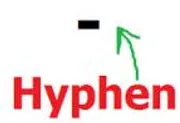Writers who get too hyphen happy end up with cluttered copy, despite the apparently skewed vision of some who think they look so dashing. On the other hand, hypo-hyphenation can cause confusion, or at least slowed reading. Sometimes a phrase can look lonely without a hyphen.
If there’s no reason for a hyphen connecting two words, it shouldn’t be used. A frequently occurring situation with unnecessary hyphenation is when an adverb ending in ly isjoined to an adjective before a noun. Notice there is no hyphen connecting frequently and occurring. Why? Because the only reason to use a hyphen here would be to show that frequently modifies occurring, not situation. But it’s obvious without the hyphen: You can’t have a frequently situation. Another example: the amazingly fast runner. Ever hear of an amazingly runner? Of course not. Obviously, amazingly goes with fast, not runner. Yet literature of all kinds is replete with the hyphen in such situations.
Hyphen neglect
Conversely, there is a situation in which a needed hyphen hardly ever is inserted. That is when one word of a compound noun, or an adverb, is joined with an adjective preceding a noun but not with the other word of the compound noun or an adverb. Here’s an example from a newspaper op-ed piece: “More fuel-efficient vehicles … .” What are we talking about here, more vehicles that are fuel-efficient, or vehicles with greater fuel efficiency? It’s not clear. The adverb More needs to be linked with fuel to indicate vehicles with greater fuel efficiency: “More-fuel-efficient… .” As it stands, the meaning is more vehicles that are fuel-efficient.

In a newspaper column compiled from entries by various news organizations, this sentence appeared: “Sen. John Cornyn, R-Texas, easily beat tea party-backed challenger Steve Stockman.” Stockman isn’t backed by any old party (neither Grand Old Party nor good old Democratic party), but by the informally constructed tea party. To make that clear, tea should be joined with party, and the two of them with backed, as was done, to show a single entity modifying challenger.
All together now
An Associated Press story read: “a brother or sister whose stem cell-rich bone marrow …
.” The bone marrow isn’t just cell-rich. It’s stem-cell-rich. All three words go together. Otherwise, stem feels like it’s been ostracized, left out there all by itself.
An hour’s not a rush — no choke.
A writer for a metropolitan South Florida paper wrote: “meetings in rush hour-choked cities … .” Those cities must be pressed for time, hour-choked as they are. Oh, wait, this is a particular hour, rush-hour, and the cities are choked by it, not by any hour in the day.
A little logic and, in such situations, a little hyphen goes a long way toward helping the reader.

